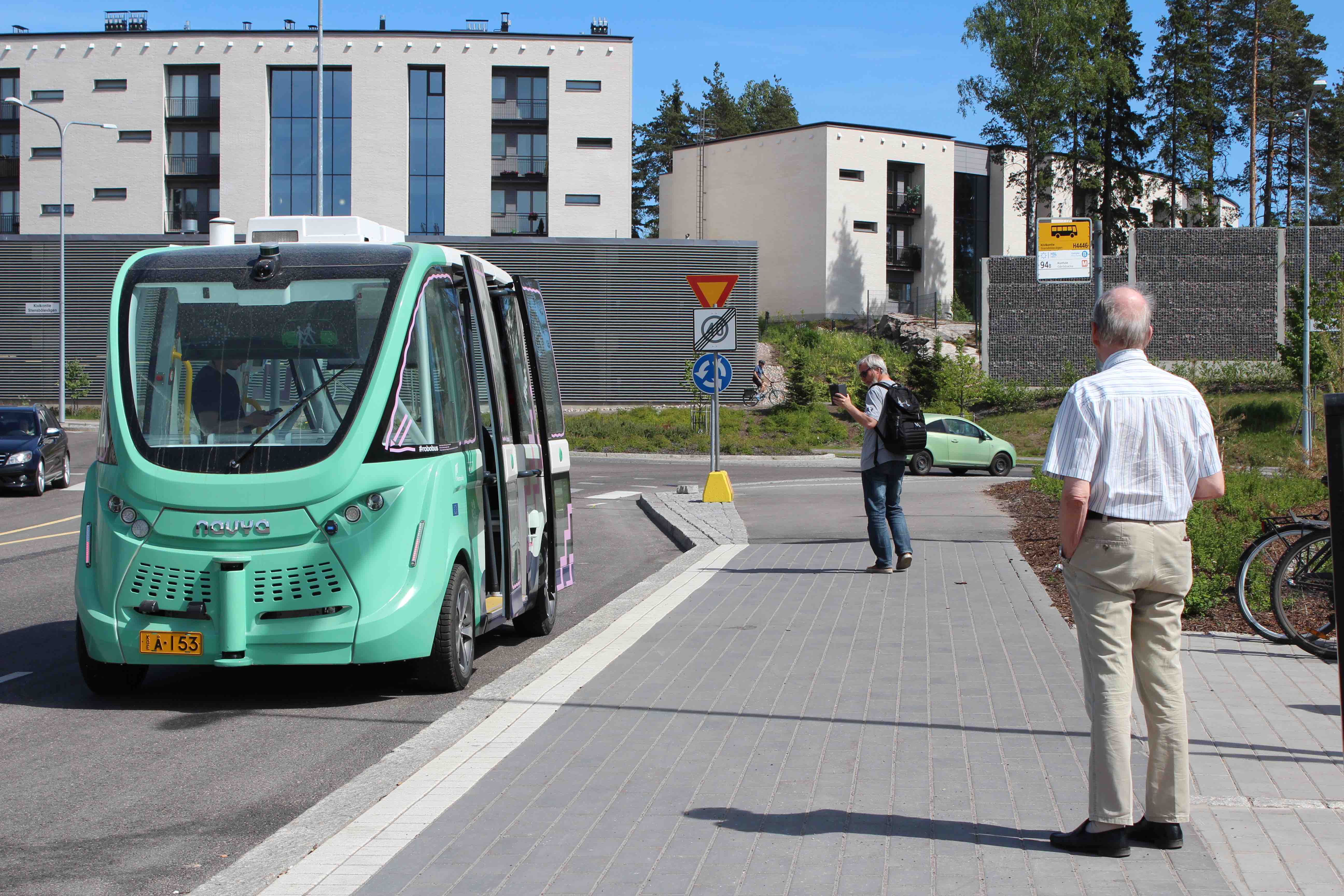People around the world are frantically searching for solutions to climate change. While public transport is one of the most obvious ways of reducing traffic emissions, its market share in Helsinki has remained largely unchanged in recent years. Robot buses may end up having a significant impact on the attractiveness of public transport.
Although the popularity of emissions-free bicycling and walking has increased in recent years, at the same time the numbers of trips made using passenger cars has also continued to rise. While it is true that passenger car technology continues to advance and the emissions of individual cars are decreasing, these developments are simply not enough to offset the increase in traffic, nor can they solve the problems related to urban environments. All motor traffic also causes noise and particle emissions, and soon there will simply not be room for all the cars we own in cities. Besides, a traffic jam is still a traffic jam even when it is composed of self-driving electric cars. The majority of Finns and people in the rest of the world are already living in cities, and urbanisation is only expected to increase in the future. The only way to address the resulting challenges is to look beyond passenger cars.
If we wish to create an urban framework ideal for the human scale, with distances short enough for walking and cycling, public transport is absolutely essential. However, despite the shared benefits of public transport, it is clear that consumers ultimately choose their mode of transport based on personal preference, on what they themselves consider ideal for the situation. What matters most is the user experience of the service, and for now at least, public transport does not offer solutions to all scenarios.
However, the situation may soon change as a result of the advancement of self-driving vehicles and especially robot buses. If the apparent potential of these technologies ends up being realised, the cost-effectiveness of public transport may soon increase dramatically, which will in turn improve the availability and quality of services. This will also have major impacts on the user experience:
1. The physical convenience of the service
Reduced operating costs will facilitate profitable public transport in areas or on routes that the current range of services does not cover. This will, in turn, allow people to access a dense public transport network with minimal physical effort. Demand-responsive transport may reach all the way to your front door.
2. The cognitive convenience of the service
Transport services will be always available and require very little cognitive effort to use. If service intervals are short enough around the clock, there will be no need to peruse timetables. This is already the case in areas with dense public transport coverage and during peak hours, but automation has the potential to significantly expand the availability of services.
3. Reliability and the perception of control
The characteristics mentioned above and the constant quality produced by automation will produce a reliable user experience. Consumers will be able to rest assured that they can always get from A to B in the area of operation of dense public transport networks, regardless of time and place.
Obviously the service experience of public transport is affected by many other factors as well, such as price and ease of payment, the quality of the infrastructure and safety. Even so, robot buses have the potential to become a significant element in the advancement of public transport and traffic as a whole. That being said, the actual travel experience will comprise not only public transport, but other forms of transport as well. Nowadays the focus is on travel chains and MaaS (Mobility as a Service), i.e. how to combine different modes of transport into a single, seamless service.
Forum Virium Helsinki is the innovation company of the City of Helsinki, which aims to build Helsinki into the most functional smart city in the world in collaboration with companies, the scientific community, the City and residents. The promotion of smart mobility is one of Forum Virium’s primary objectives
Helsinki is an excellent test platform for piloting smart mobility solutions. The city has already served as a testbed for numerous robot bus and other smart mobility experiments, which Forum Virium has been involved in as a major cooperation partner. These experiments are part of an ongoing process in which new technologies are gradually tested in increasingly challenging environments. The experiments will continue in summer 2019 with the launch of the Sohjoa Baltic project’s robot bus pilot in Helsinki and the continuation of the MySmartLife robot bus that began in Kivikko last year. The Fabulos project coordinated by Forum Virium is also still ongoing and will be operating several robot buses in 2020.
Read more about Forum Virium’s ongoing projects on our website!
Robot car projects in Finland
- 2015 CityMobil2. Vantaa, Kivistö. EasyMile bus. The trial route was approximately one kilometre in length, extending from Kivistö station to the vicinity of the Vantaa housing fair area via a pedestrian and cycling lane closed off from other traffic.
- 2016–17 SOHJOA 6Aika. Helsinki, Hernesaari. Tampere, Hervanta. Espoo, Otaniemi. EasyMile bus. Operation in other road traffic. The purpose of the project was to examine the functionality of the vehicle in Finnish conditions.
- 2018–20 Helsinki RoboBusLine. The Navya bus operated in other road traffic in Kivikko, Helsinki as a continuous service. The bus was visible in HSL’s services with the route ID 94R. The experiment will continue in summer 2019.
- 2018–19 Sensible4. Initial testing with an adapted Renault Twizy with Sensible4 software. The aim was to test suitability in challenging weather conditions. A new Gacha bus is currently in development in collaboration with MUJI. Routes in Muonio, Vantaa, Tampere, Hämeenlinna and Espoo.
- 2016–19 VTT. Robot car ‘Marilyn,’ an automated vehicle adapted from a Citroën C4. Robot car ‘Martti,’ an automated vehicle adapted from a Volkswagen Touareg. Development of sensor technology and 5G solutions, especially for challenging weather conditions.
- 2018–19 National Land Survey of Finland, Arctic Winter Vision. Test vehicle adapted from a Ford Mondeo. Development of sensor data applications.
- 2017–20 Sohjoa Baltic. Conceptualisation, research and impact assessment of robot bus traffic. Next summer, a robot bus will be operated in Helsinki in an urban environment, mixed in with other traffic.
- 2017–20 FABULOS. Experimentation in pre-commercial procurement and robot bus traffic. In 2020, a public transport route operated with several robot buses in an urban environment, mixed in with other traffic.
Photo: Ruska Tapiovaara / Forum Virium Helsinki
More info

Jari Honkonen
#smartcity #smartmobility #userexperience
#servicedesign #openinnovations #sohjoa
Mobile: +358 40 501 4528
jari.honkonen(at)forumvirium.fi
